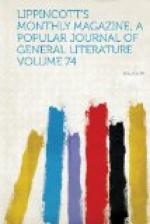On the railroad midway between Cheyenne and Denver lies the new town of Greeley. Although not on the maps in 1870, it now contains fifteen hundred inhabitants, forty or fifty stores, six hotels, churches, schools, and all the apparatus of civilization. This aspiring town, 4779 feet above the sea-level, is an example of those colony towns so successful in the West, and on which we must depend for rebuilding society in the South. Greeley is surrounded by fertile farms, and every city lot looks fresh and green: all this is effected by irrigation. Two canals have been dug from the head-waters of the Platte—one twenty-six miles long, which will water fifty thousand acres; the other ten miles long, to furnish water for the town and five thousand acres. The prairie where it is not irrigated now, in midsummer, looks burned up and covered with a parched herbage, which, however unpromising to the eye, is really good sweet hay, dried and preserved by the hand of Nature for the buffalo and antelope, and now cropped by the flocks and herds of the white man.
Denver, the capital of the Territory, contains about eight thousand inhabitants. It is a true specimen of a Western town which fully believes in itself, and blows a loud trumpet from its elevation of five thousand feet. It was said of old “that the meek shall inherit the earth,” but it was not by that quality that the Denverites obtained their location. Here are plenty of hotels, three banks and a mint: five railroads centre here, bringing in ten thousand tons of freight per month. Denver has schools and churches in satisfactory numbers, and her merchants sell ten millions of dollars’ worth of goods per annum. Considering that the place was only settled in 1858, and has in these fifteen years been destroyed both by fire and water, and almost starved by an Indian blockade, it must be admitted to be a pretty smart specimen of a Western city.
We ride in a ’bus, city fashion, to the Broadwell House, a fatigued-looking structure of the earlier period, but probably no worse than the others. Directly we begin to plan an excursion to the South Park, seventy-five miles distant, and going out to look for wagon and horses, we catch our first sight of the Rocky Mountains, a line of dim, misty heights, with the more pronounced outline of the foot-hills beneath. We engage a strong covered wagon, with a good pair of horses and a driver, the latter only seventeen years old, but owner of the team, and carrying himself man-fashion, with the precocity of the Western youth. The wagon is brought to the hotel and loaded, so as to be ready for an early start in the morning: we have a tent and camp-equipage, with gun and fishing-rods for Levell and Scribe, and the sketching-gear belonging to Sepia.
So on the 18th, at 8 A.M., we drive over the bridge which crosses Cherry Creek, and then cross six miles of uninhabited prairie, seamed with gulches, and brown with withered herbage and cactus—no verdure except along the canals, where several species of Artemisia and a prickly poppy with a large white flower grow profusely. We then begin to mount the bare foot-hills, among which are curious masses of red rock as large as city churches, and washed by the storms of ages into various fantastic forms. We then enter a ravine or canon through which flows Bear Creek, a tributary of the Platte.




